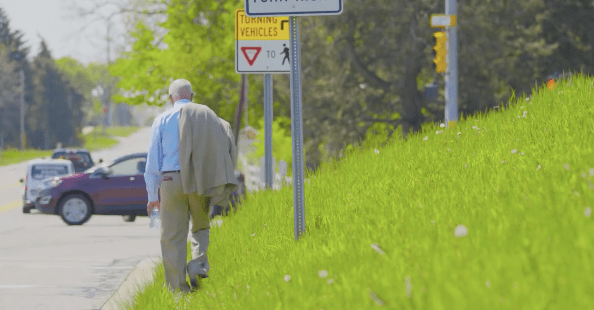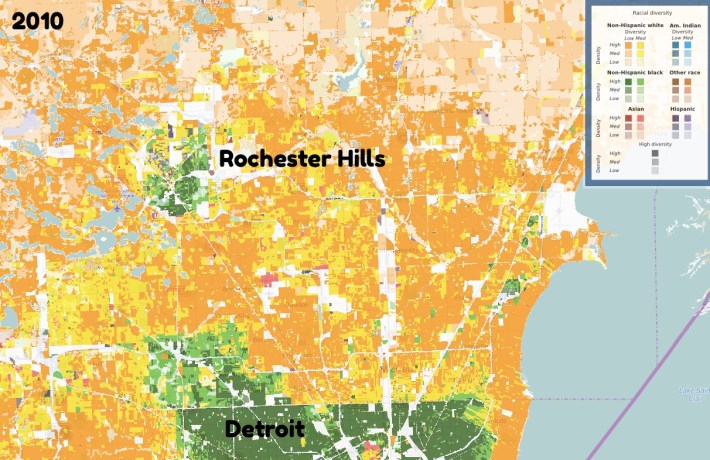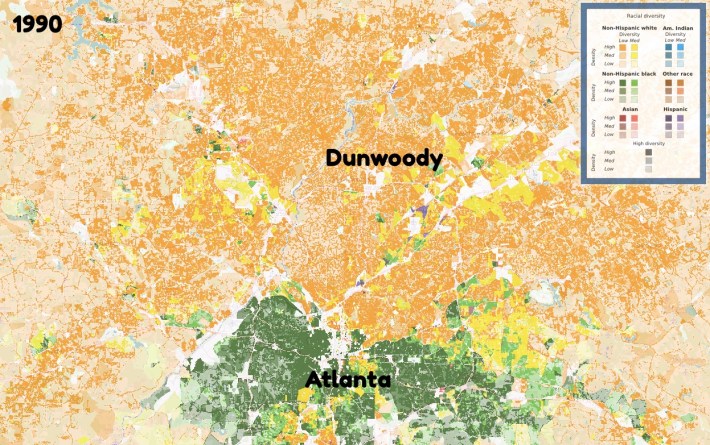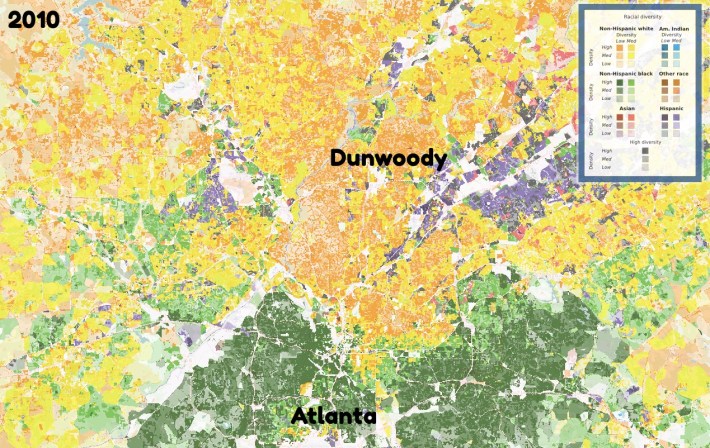Detroit and Atlanta are 1,000 miles apart, one city fighting back from the edge, the other an engine of the New South. But the metropolises are similar in one important respect: their suburbs long fought the expansion of transit — part of a segregation battle that dates back to the Civil Rights era. The suburbs of both cities are finally changing — growing more demographically diverse — and with those changes comes less resistance to better transportation options. Here's Streetsblog's look at the latest trends in both cities.
Rochester Hills, Michigan is a wealthy Detroit suburb that has, for a long time, pointedly rejected transit — and it's making life difficult for pharmacy student named Corey Rowe and countless others like him.
In a recent Medium post, Rowe made an earnest plea for transit in the suburb — a transit desert made famous after the 21-mile round trip walking commute of Detroit resident James Robertson went viral in 2015, and earned him the nickname "Detroit's Walking Man."
Rowe cited factory worker Robertson, plus his own experience as a student at Oakland University, as examples of how decades-old anti-transit policies crush the working class. Rochester Hills —one of nine Oakland County suburbs that "ops out" of metro Detroit's suburban transit system, SMART — doesn't even have a simple bus line headed to Detroit or a community circulator students can use.
But Rochester Hills's refusal to fund transit service of any kind can exert an especially brutal toll on low-income workers, like Robertson, who may need to commute into the suburb from other areas. He was taking two buses to reach his factory job in the suburb and then walking the extra eight miles to and 13 miles home (thanks to late-night bus service reductions) in the dark, when someone at the Detroit Free Press got wind of the story and held him up as an exemplar of work ethic.
In some of the wealthy, mostly white suburbs of Oakland County, north of Detroit, like Rochester Hills, refusing to allow transit service has a long, ugly history.
Historically, a lack of transit helped maintain racial segregation. The county's powerful executive, Brooks Patterson, is a master of old-school dog-whistle segregationist policies. He got his start in politics in the 1970s opposing the integration of Pontiac Public Schools before becoming county exec in 1993.
He did support the region's four-county transit expansion ballot proposal in 2016, but has since become the biggest barrier to better bus service across the region.
But wealthy Oakland County, population 1.25 million, is changing demographically, as you can see on the maps below. The population diversity is also affecting attitudes about transit.
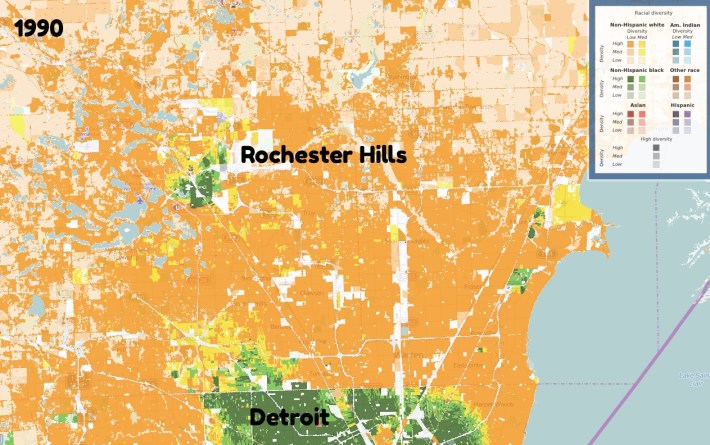
The region is still very segregated. But since 1990, the hard wall between Detroit and Oakland and Macomb counties (there is an actual wall that remains along 8 Mile at the border from the days of more overt segregation) has softened. You can still see the county line — where it changes from green (black majority areas) to orange (white majority areas) on the map. But the black population has traveled north some, especially north-west, turning the dark orange areas into yellow and even light green. There's also a larger Asian population (shown in red) in both Detroit and Oakland County.
Overall, the county has shed about 70,000 white residents over the last two decades. At the same time it gained about 50,000 black residents, 40,000 Asian residents and 20,000 Latino residents.
Meanwhile, Detroit, which is still 79 percent black, has become slightly whiter. The city added 14,000 white people between 2010 and 2014, the Detroit News reported, the most since the 1950s when the city's population was more than double its current total.
The shifting populations will likely shift perceptions about transit. The 2016 ballot issue that would have built a relatively robust four-county transit system was defeated by only one percent. Even in Rochester Hills, 47 precent of voters backed the measure. But the trend is definitely towards transit.
"White suburbanites are more likely to go downtown these days than they were in the 1980s or '90s. To some extent, that may make them more likely to support transit," said Joel Batterman, a Ph.D. student in urban planning at University of Michigan. "I’m not sure people are changing their attitudes as much as having a more diverse population in the county has changed the political orientation."
The main impediment now is Brooks Paterson, who won't bring transit back to the ballot. Last year in his State of the County speech, he said he would not make any move on transit because cities like Rochester Hills have opted out of the transit system — a justification for the status quo.
"I will not betray them and slip some, or all of them, into a tax machine from which they can expect little or no return on their investment," Patterson said of the nine opt-out cities.
But Patterson's power to stop momentum for transit is in trouble. In March, the 80-year-old announced he has been diagnosed with stage 4 pancreatic cancer, which could force him to step down.
Should he do so, his successor would be appointed by a newly elected Democratic majority (the county's first since the 1970s) on the Oakland County Board of Commissioners. The transition to a Democratic County executive could lead to a new ballot initiative — and neighboring Macomb County might support the move. The executives of the two other counties — Wayne (Detroit) and Washtenaw (Ann Arbor) — are already supportive.
Stay tuned.
Atlanta
Meanwhile, a similar sea change has been happening in Atlanta, another majority black city whose suburbs for years resisted transit expansion.
The city's heavy rail transit system, MARTA, has been relatively stagnant since the mid-1960s, when it was formed. That all goes back to two crucial votes in the late 1960s and '70s.
"The failure to extend MARTA into the suburbs," Doug Monroe wrote in Atlanta Magazine in a widely shared article in 2012, was "the mother of all mistakes."
"It wasn’t just a one-time blunder," Monroe continued, "it was the single worst mistake in a whole cluster bomb of missteps, errors, power plays, and just plain meanness that created the region’s transportation infrastructure."
The event was called the transit compromise of 1971, says Monroe. It followed decisions in 1965 and 1971 by Atlanta's (at the time mostly white) suburban counties — Cobb, Gwinnett and Clayton — to reject joining MARTA, votes Monroe called "referendums on race."
"It was just the idea of the trains bringing the wrong people to town," says King Williams, a writer for the local real estate site Saporta Report.
Because Atlanta never had the support of the suburbs, the heavy rail system was never north of the city — even as the region's population ballooned.
MARTA has barely expanded heavy rail since the 1970s, and the system comprises just 48 miles. Compare that the Washington, D.C., meanwhile, which has steadily expanded its system since its opening around the same time. That system now stretches 118 miles and has major expansions in the works. As a result, in part, Washington, D.C. has about 6.5 times the transit ridership per capita as Atlanta.
But like Detroit, Atlanta's suburbs are becoming more diverse — and the political landscape for transit is shifting as well.
The changes in Atlanta's northern suburbs are much more stark than in Detroit. Atlanta's black population (green) has moved north and especially northeast. And the Hispanic population (purple) has exploded in Cobb and Gwinnett counties. Notice how north of Atlanta, there are hardly any areas that are solid orange (which shows homogenous white areas). Now most areas are yellow, which indicates some degree of diversity
This is really shaking up how transit support.
Clayton County, to Atlanta's south, voted to join MARTA in 2014, with a 74-percent majority. That county is now 66 percent black and 19 percent white.
Gwinnett and Cobb county, which are shown on the map, have not done so yet, but each is moving in that direction, said Williams. Gwinnett County, now just 55 percent white, will likely be first.
Right now, Gwinnett County (population 900,000) is still controlled by Republicans, who helped kill a recent transit expansion measure by putting it on the ballot in a weird, low-turnout March election. Only about 90,000 votes were cast and it failed by about 9,000.
But most observers think transit expansion to Gwinnett County is inevitable.
MARTA is already buying up land to expand heavy rail into the south part of the county, said Williams.
Democrats are threatening to take the county. Seven Gwinnett County statehouse districts flipped to Democrats in the 2018 election. Stacy Abrams won the county by 14 points in her gubernatorial race.
Gwinnett County Commission Chairwoman Charlotte Nash (a moderate Republican) recently announced she wouldn't seek reelection in 2020, perhaps seeing the writing on the wall that Democrats would soon take the majority.
Williams, the real estate writer, says the effort to sabotage transit by placing it in a low-turnout election that would draw more older white people who are more hostile to transit, will likely backfire for Gwinnett Republicans. If the county flips, Democratic leaders will probably pursue a much more aggressive transit expansion plan.
"I think they’re trying to hold off progress," he said. "They don’t understand their future constituent they’re going to push it much further and farther than they even wanted to."
Nearby Cobb County may be next as well.
"Cobb County is still majority white, but the Hispanic population is growing. African-Americans are getting priced out of the city of Atlanta," said Williams. "It's just a matter of time."
